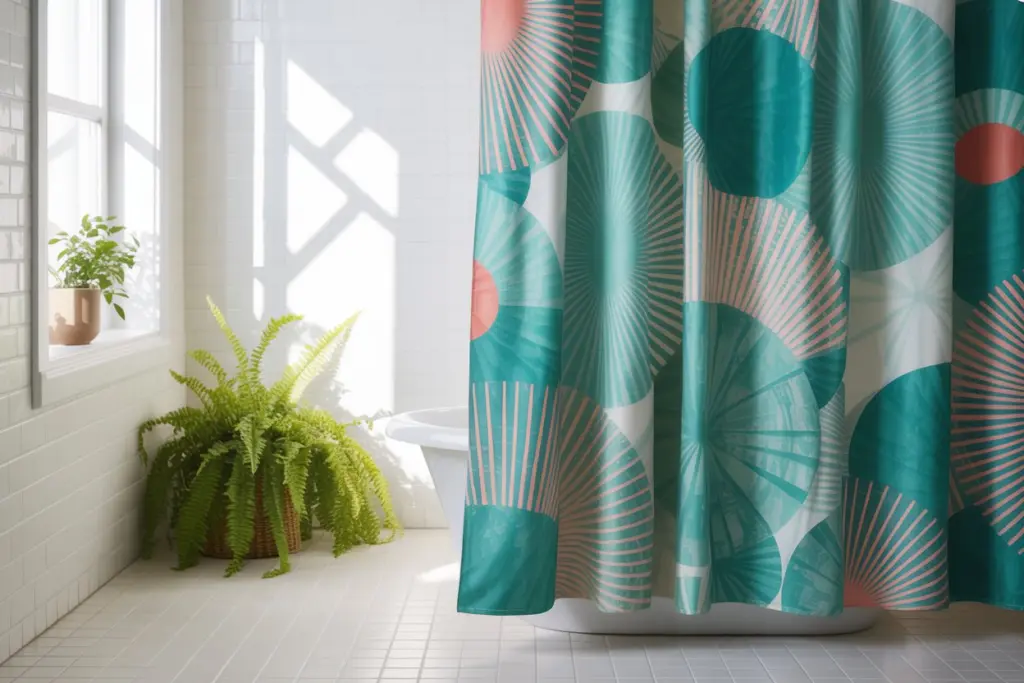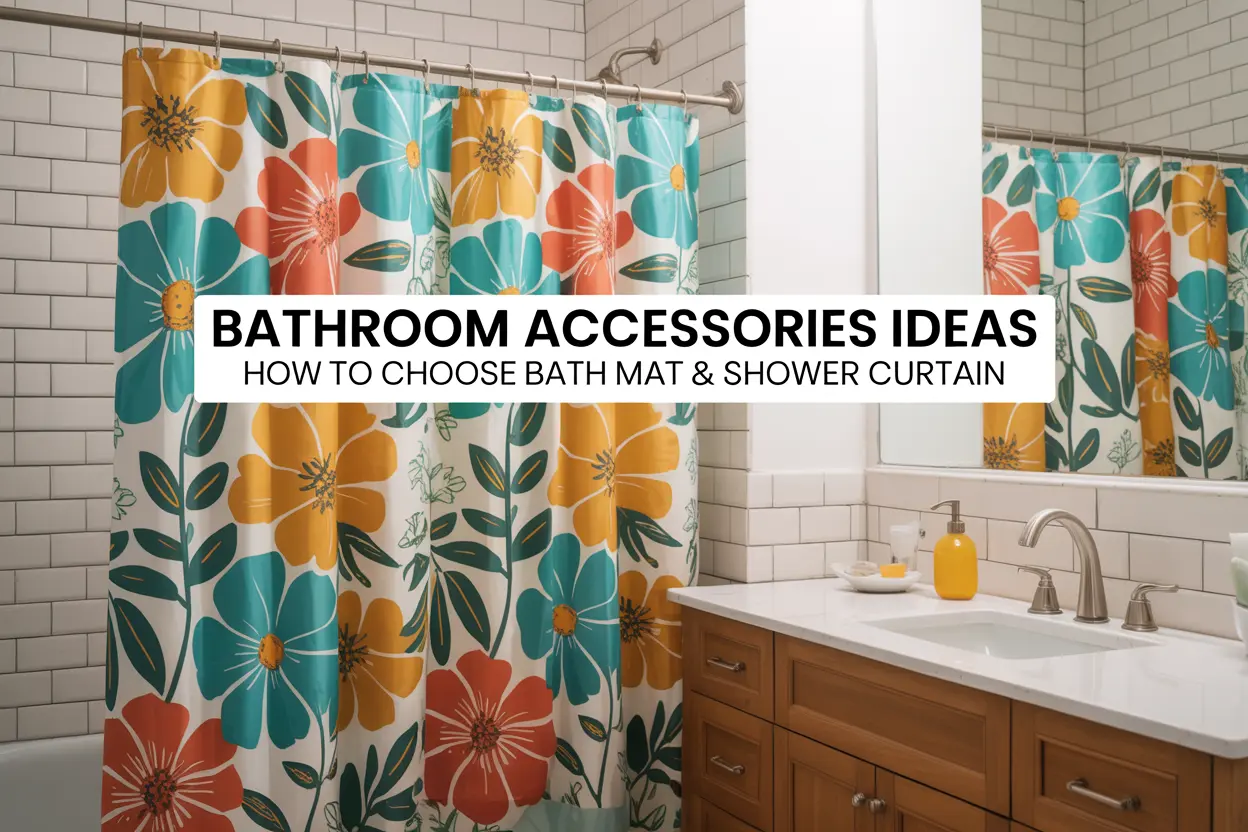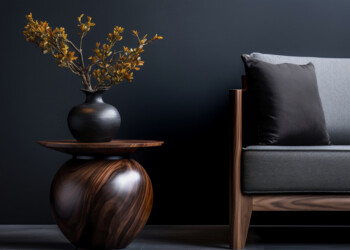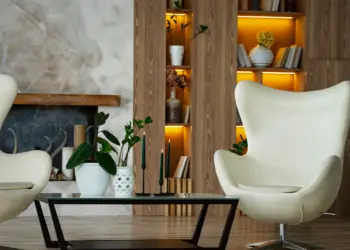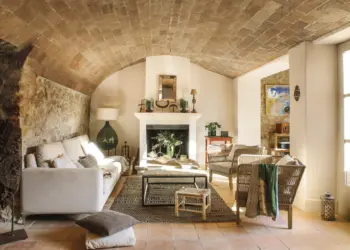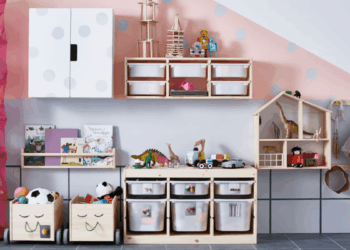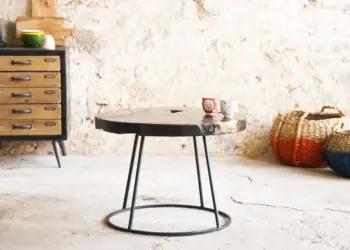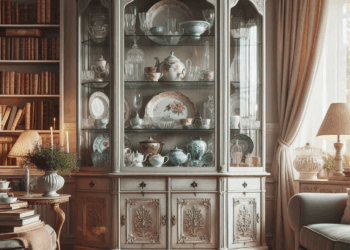The bathroom is one of the most intimate and personal spaces in our home. It’s where we start our day, getting ready to face the outside world, and where we relax after a long day’s work. To create a pleasant, functional atmosphere in your bathroom, the choice of shower mat, curtain, and other bathroom accessories plays a crucial role. Not only do they add a touch of style to the room, they also offer practical features that enhance your experience in this private space.
In this article, we’ll guide you through the key aspects to consider when choosing the perfect bathroom mat and shower curtain. We’ll cover topics such as appropriate materials, colors and patterns to suit your style and décor, as well as practical tips for the care and durability of these indispensable bathroom accessories.
Table of Contents
Bathroom accessories: How to choose a bath rug?
A bath mat is indispensable among bathroom accessories: it keeps your bathroom clean and prevents water from getting everywhere when you get out of the shower or bath. It also reduces the risk of slipping when your feet are wet, and, quite simply, it’s an extra comfort to put your feet down on a soft mat! But how do you choose a bath mat? Here’s my advice!
What weight for a bath rug?
The choice of a bath mat depends not only on its material or size, which we’ll look at later in the article, but also on its weight! The weight of a bath rug indicates its absorption capacity; the higher the weight, the more effective the mat will be at drying your feet. So it’s all the more important to take weight into account when choosing your bath towel! For effective absorption, choose a bath mat with a minimum weight of 900g/m2. For body towels, choose at least 500g/m2!
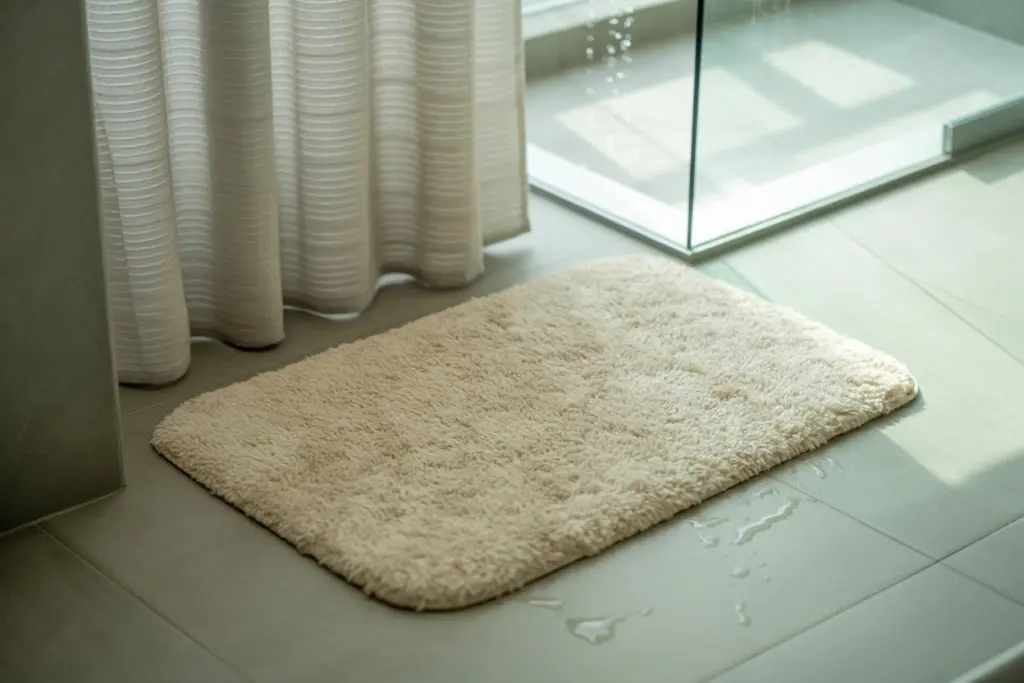
What size bath rug should I choose for my bathroom accessories?
To find out which size bath mat to choose, start by measuring the size of your shower, bath or vanity unit to find out which size mat will be best suited to your bathroom. For small bathrooms, opt for a 50x70cm or 50x80cm square or rectangular mat, perfectly suited to small spaces. For larger bathrooms, opt for a 60x90cm or 60x100cm rectangular mat to cover a larger area of your tiles.
Rectangular, square or oval, mini or XXL size, memory foam or flat, trendy with pattern or plain… there are a multitude of bath mat models, in different shapes and sizes, to create a harmonious decor in the bathroom. When placed opposite a washbasin, the length of the bathmat should be at least the same as the width of the vanity unit. Furthermore, when placed at the foot of a bathtub or shower, the bath mat should be wide enough to cover the bathtub exit, thus limiting splashes on the tiles, at the risk of a slippery floor.
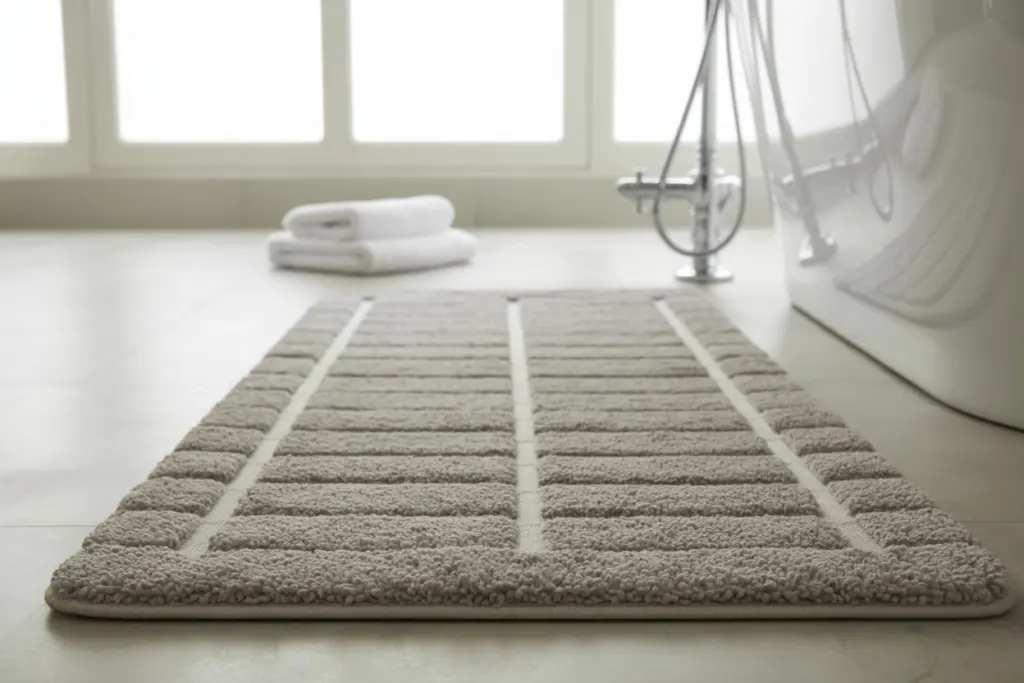
Among the standard dimensions often found are:
- 60×60 cm shower square.
- Bath front 60×100 cm.
- The classic 50×75 cm or 50×80 cm mat.
If you have a toilet in your bathroom, you should know that “contour toilet” mats are becoming less and less popular.
The shape of the bath rug
Let’s start by demonstrating the two shapes of bath mats!
Round bathmats: ideal for apartments
Round bathmats, unlike rectangle bathmats, are only used in the minority, because they’re much more contextual! Indeed, round or oval bath mats are often limited in size. As a result, they’re best suited to shower cubicle owners! Suitable for small bathrooms, round bath mats don’t have corners, so they save a few square centimeters of surface area. A great alternative for small apartments!
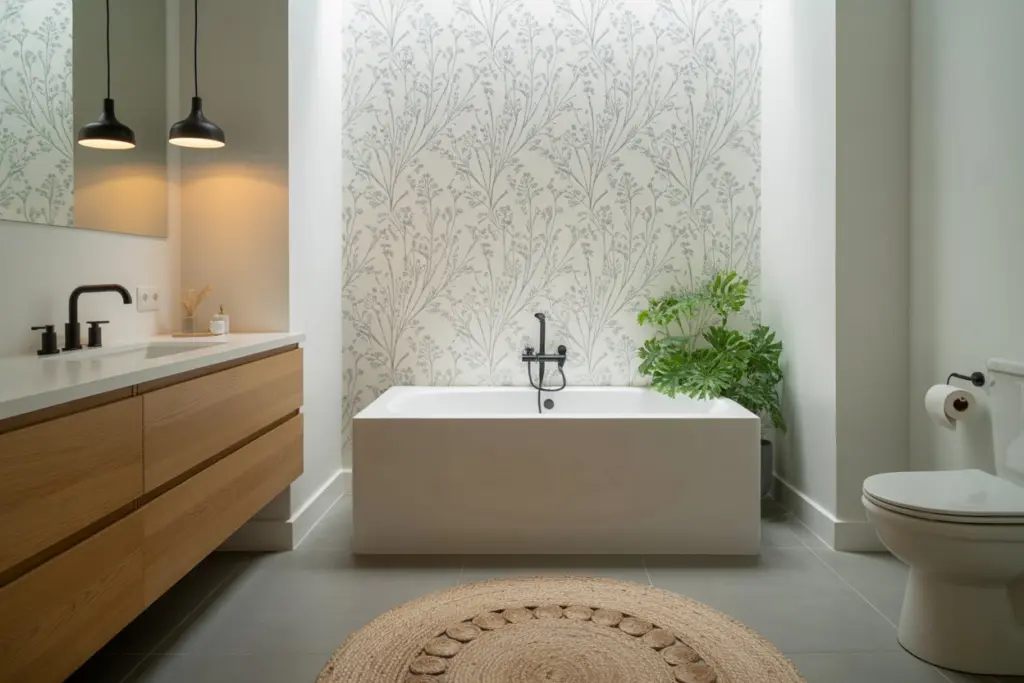
Large bath mats: for large bathrooms
Large bathroom mats are the antagonists of round mats! Larger in size and rectangle, they are perfect for large bathrooms or for parents with several children of the same age bathing together.
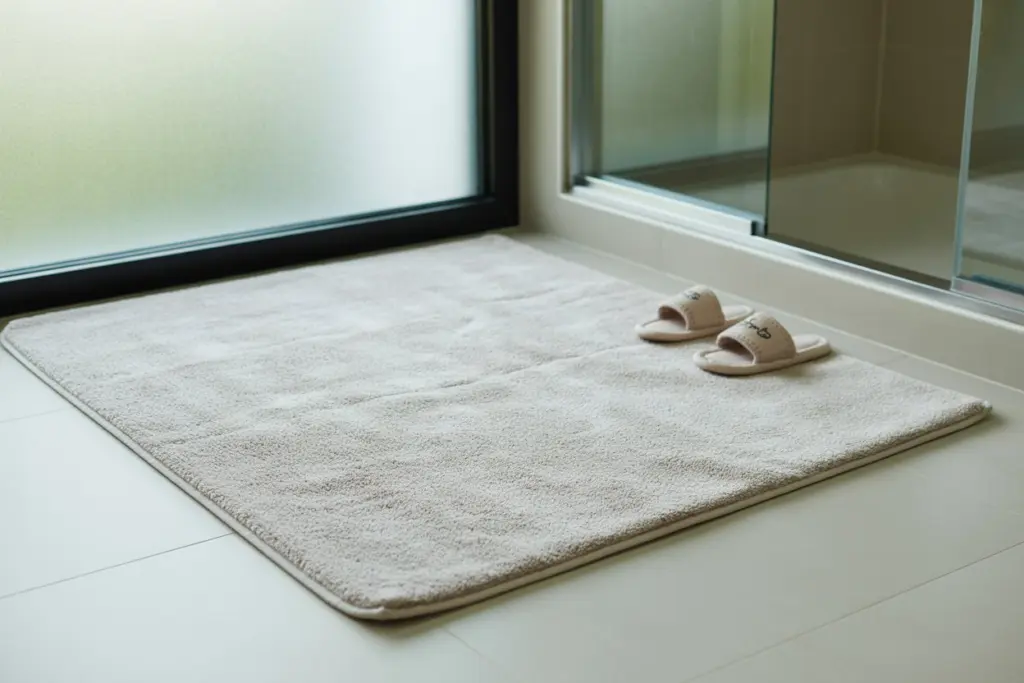
The specific characteristics of your shower mat
Let’s move on to mats with a few special features, each offering its own advantages!
Non-slip bath mats: essential for your bathtub
First of all, non-slip bath mats are among the most widely used! Thanks to the suction cups glued to the underside of the mat, it won’t slip. This is a must if you want to install a mat for your bathtub.
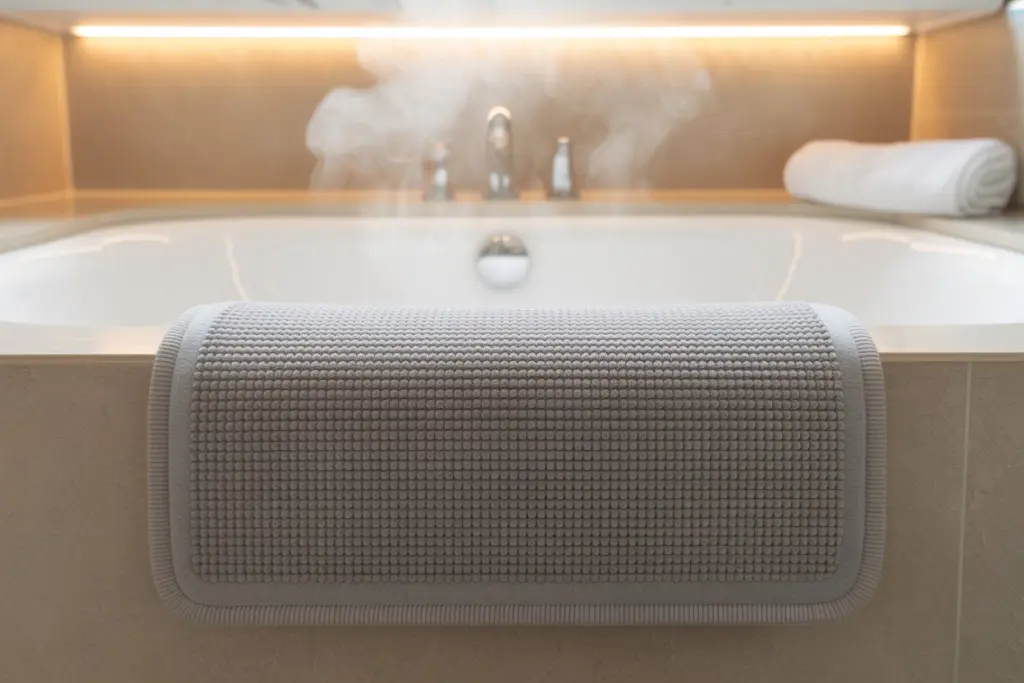
Bathroom accessories: Original bath mats
If you’re not looking for absolute carpet optimization, but rather originality and style, then original bath mats could be just what you’re looking for! With fun patterns, more or less random shapes and a variety of colors, you’re bound to find a mat to suit your taste!

Bathroom accessories: Diatomite bath mat
Let’s finish our bath mat presentations with diatomite mats! Diatomite is an extremely porous rock rich in silicon. Sicilium is the little pouch found in the pockets of certain garments or accessories such as school kits, to capture as much moisture as possible!
As you’d expect, then, the combination of small holes and silicon greatly enhances water absorption. In fact, a diatomite mat will dry your feet completely in a matter of seconds! This is the mat par excellence if you’re looking for efficiency.
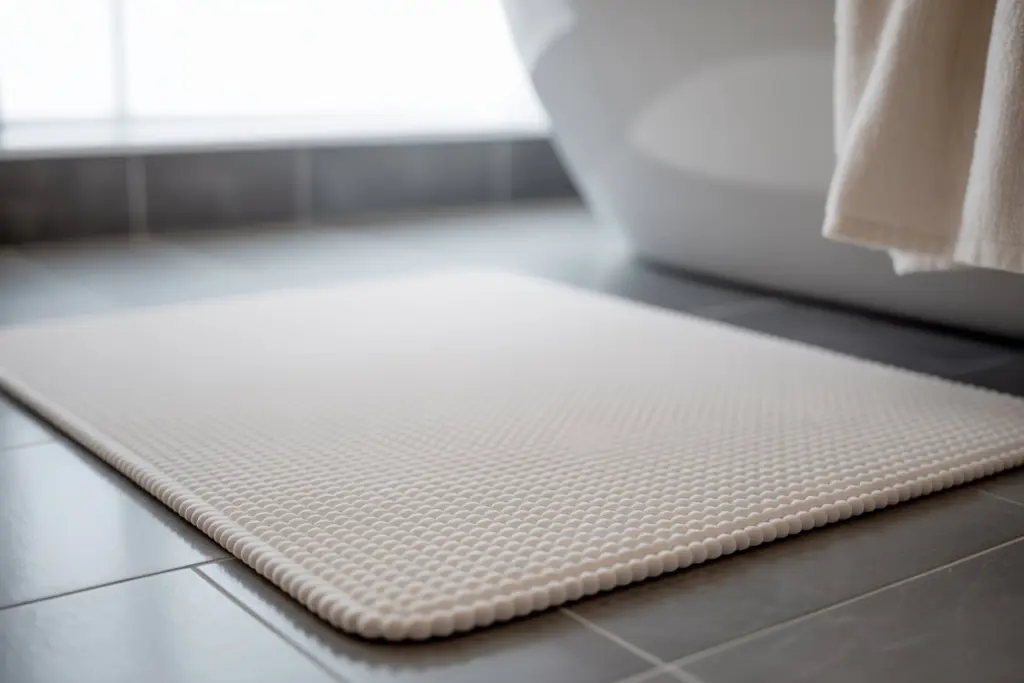
Which material for your bathroom mat?
Let’s finish this article by listing the materials most commonly used in bathroom mats, with their advantages and disadvantages:
Rubber: this is the most widely used material. Resistant and inexpensive, they offer the advantage of not slipping when in contact with water. This is the material used for bathroom mats with suction cups.
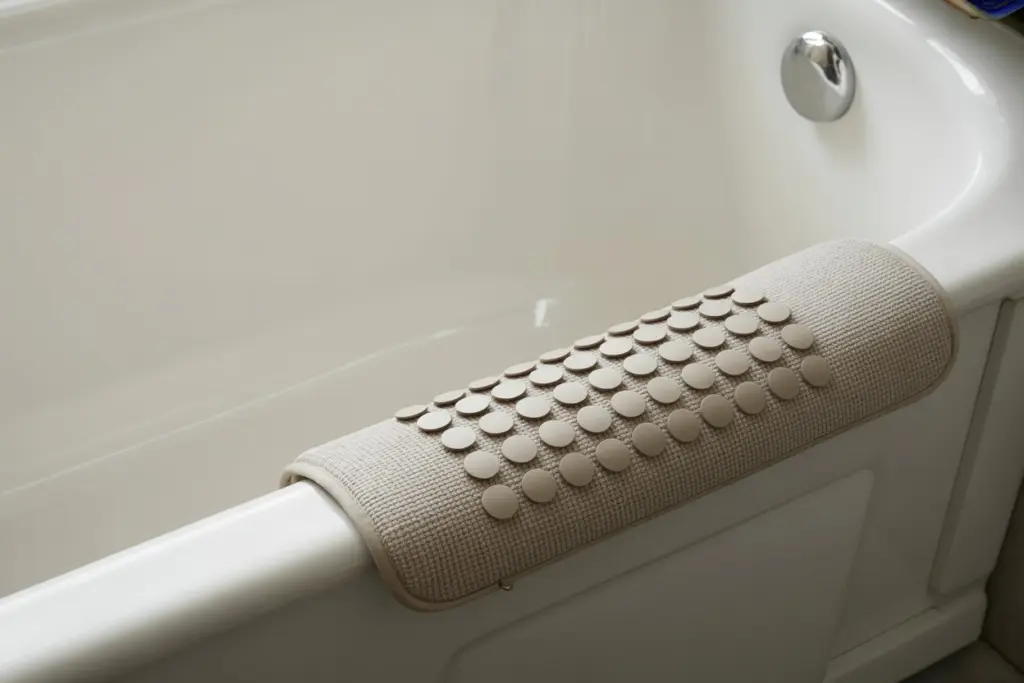
Polyester: polyester has the advantage of being water-absorbent and easy to clean! It’s the first choice for shower exit mats.
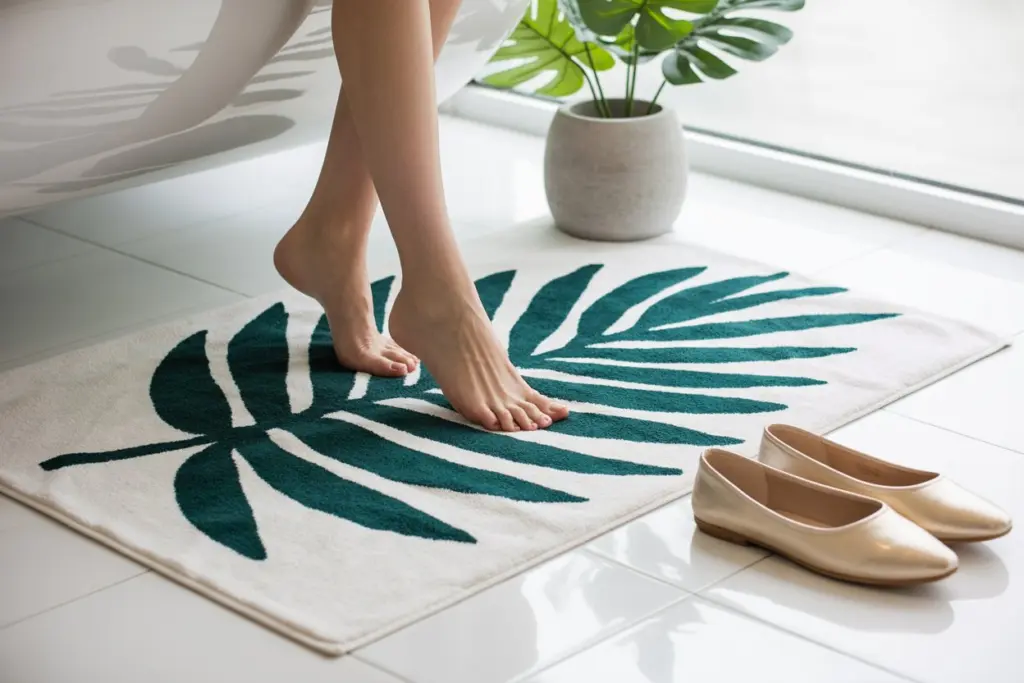
Cotton: just like polyester bath mats, cotton mats allow you to get out of the water safely. Cotton mats have the advantage of being more absorbent than polyester, although cotton is slightly more expensive than polyester mats!
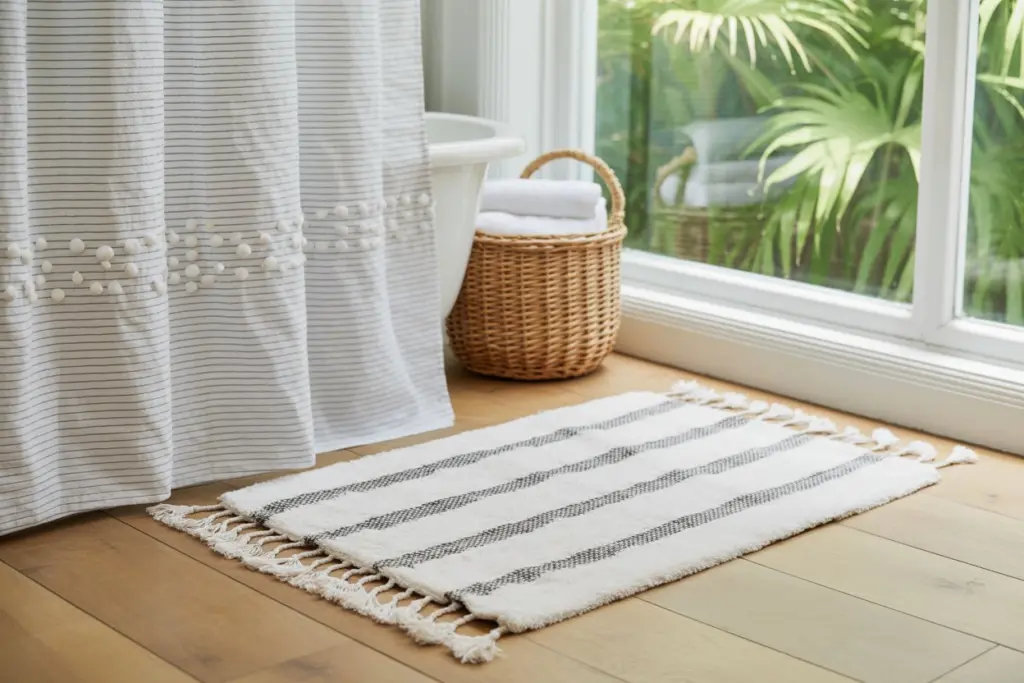
Diatomite: as mentioned above, this is the best material for your bath mat! Highly absorbent, this is the luxury mat.
PVC: avoid PVC bath mats! Very rigid and non-absorbent, they are of little interest as bathroom mats.
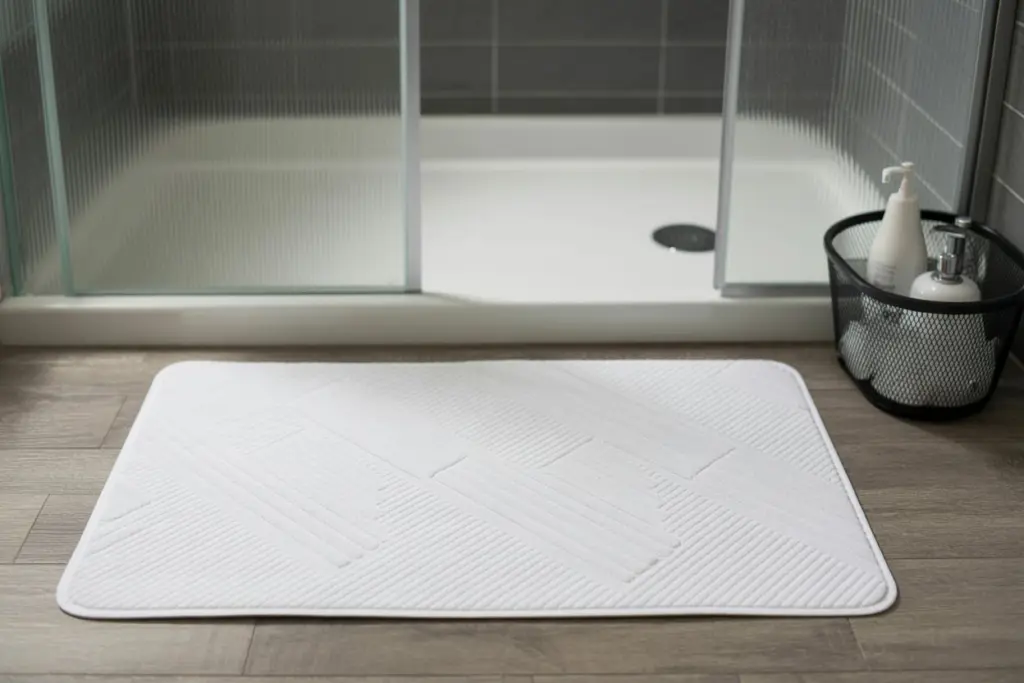
Choose the design of your bath mat to match your bathroom accessories
Today’s bath mats come in all colors, from the classic beige, white, gray and navy blue to vitamin-rich colors like apple green, raspberry, yellow and many more.
If you’ve got an all-white bathroom, you’re spoilt for choice when it comes to color! You can also use bath mats to subtly echo the patterns of your tiles.
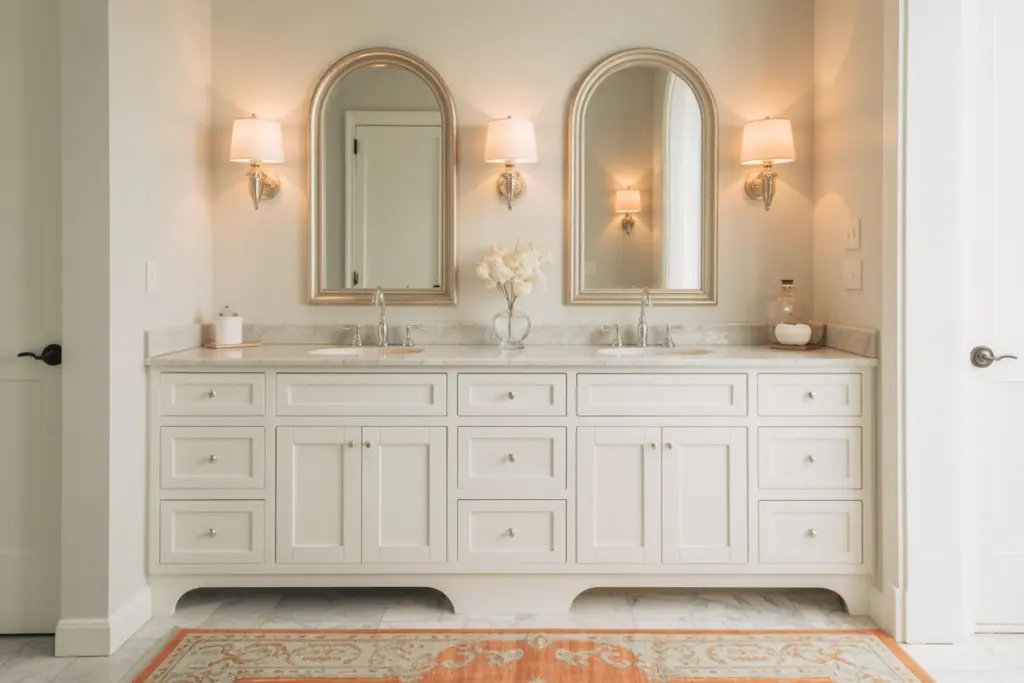
If your bathroom is already very colorful, I’d advise you to play either with tone on tone, or with the complementary color. For example, my bathroom is in beige/brown, so I can opt for either a beige rug itself, or an apple green rug, a color that goes well with brown.
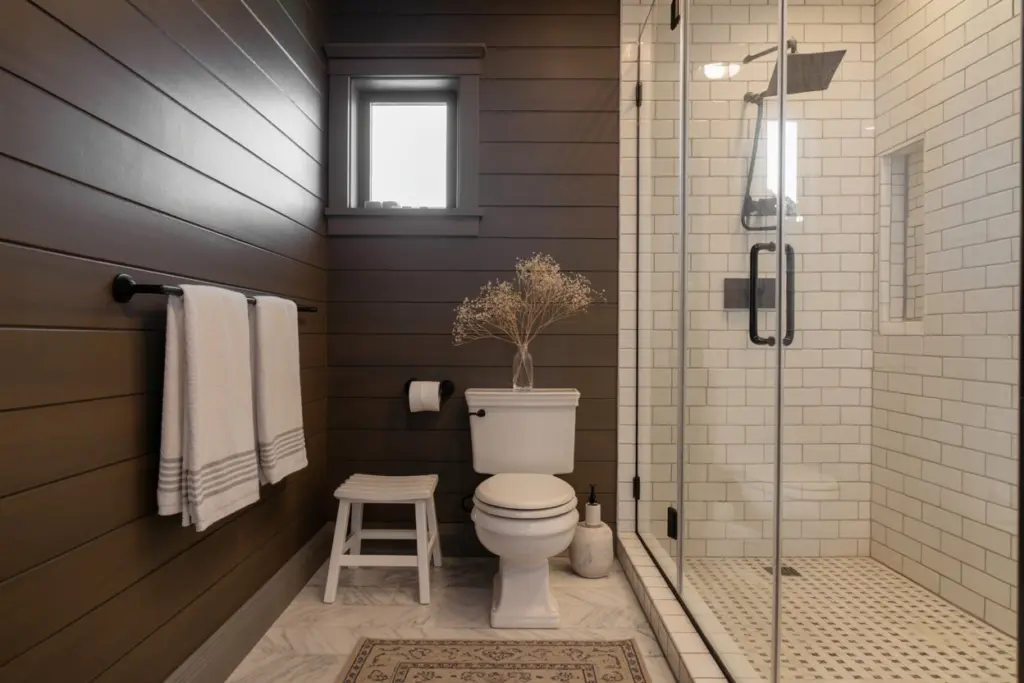
Then, you can echo the color of your rug in a few bathroom accessories or frames: pretty baskets, guest towels or washcloths, “zen” canvases to hang, a pretty potty…
Before you buy, take a look at customer reviews of the rugs you’ve spotted. You’ll get important information about color, carpet absorbency, thickness, comfort, how it sits on the floor…
How do I clean a bathroom rug?
Just like a bath towel, you should wash your bathroom carpet regularly to remove any stains and bacteria. Air-drying, vacuuming or washing in a washing machine are just some of the simple steps you can take to maintain and clean your cotton, foam or microfiber bath mat, so that it lasts a long time.
- Shake or vacuum your bath mat regularly to remove dust, hair and other impurities.
- After each use, air-dry your bath mat to prevent bathroom humidity from sticking to it.
- Finally, wash your bath mat once a week to keep your bathroom clean. A 40°C wash is enough to thoroughly clean your mat and eliminate bacteria.
Bathroom accessories: how to choose shower curtain and install it?
Why a shower curtain? What material should I choose? How to install it in the bathroom?
Why invest in a shower curtain among essential bathroom accessories?
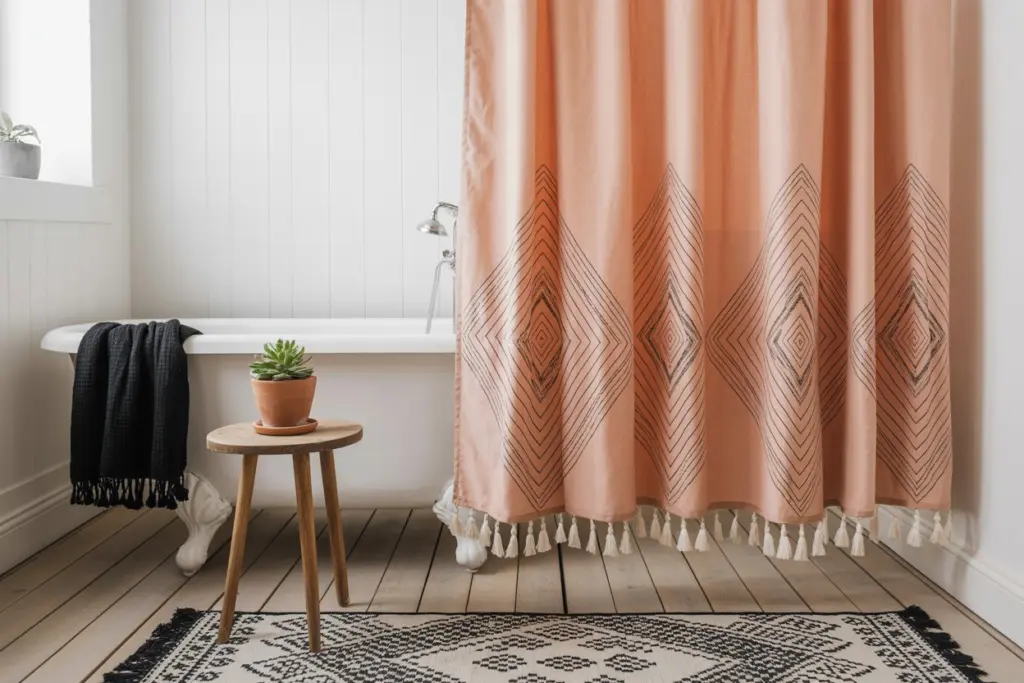
A shower curtain for protection
Whether you have a shower or a bathtub, water and soap splashes in your bathroom are inevitable if you have no means of protection. A shower curtain is one way of preventing your room from turning into a swimming pool, and also preserves your privacy.
A shower curtain for decoration
As well as protecting the bathroom, the shower curtain has a real decorative value. As an integral part of the room, it acts as a decorative accessory, just as towels or bath mats can. In fact, there’s a very wide choice of shower curtains on the market, in terms of size, material, color, pattern and fastening.
A practical accessory
A shower curtain is also a practical accessory when it comes to installation and maintenance. Installing a shower curtain, for example, is quicker and easier than fitting glass partitions. It’s also an accessory that can be easily removed and washed in the washing machine or by hand.
Shower curtain sizes and styles
Unlike shower enclosures or shower screens, shower curtains are easy to install and change, and much less expensive. They come in a wide range of materials, colors and patterns to match every style. To make it a decorating accessory in its own right, choose a shower curtain that matches the bathroom’s design, even if any fantasy is permitted.
Shower curtains are available in standard sizes: 180 × 180 cm, 180 × 200 cm or 120 × 200 cm, as well as made-to-measure, although the price then rises.
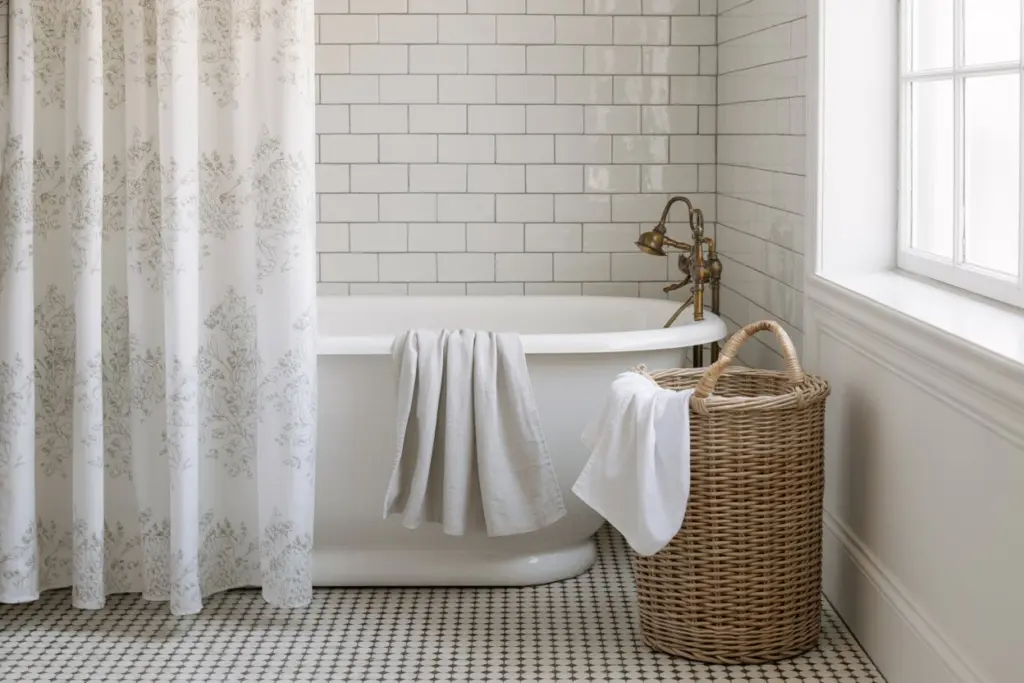
Good to know: the shower curtain must be positioned inside the shower tray without touching the bottom, so that it dries between showers and doesn’t mildew.
What material should I use for my shower curtain?
Plastic shower curtains
bathroom accessories: PVC shower curtains
PVC (polyvinyl chloride) shower curtains are the most common type on the market. They’re generally the least expensive, and boast many qualities, including waterproofing, thinness and lightness.
Although they’re not designed to be machine-washed, they’re relatively easy to maintain, as all you need to do is immerse them in a little soapy water and white vinegar.
However, we sometimes criticize PVC for its tendency to stick to our skin when we wash. It’s also susceptible to mildew: if it’s too long and hangs around at the bottom of the shower or bath, it won’t dry properly and black spots will quickly appear. It can also turn yellow, especially if it’s white or light-colored.
In short, a PVC shower curtain is relatively inexpensive but doesn’t last forever. Itt will eventually wear out, so you need to think about changing it regularly.
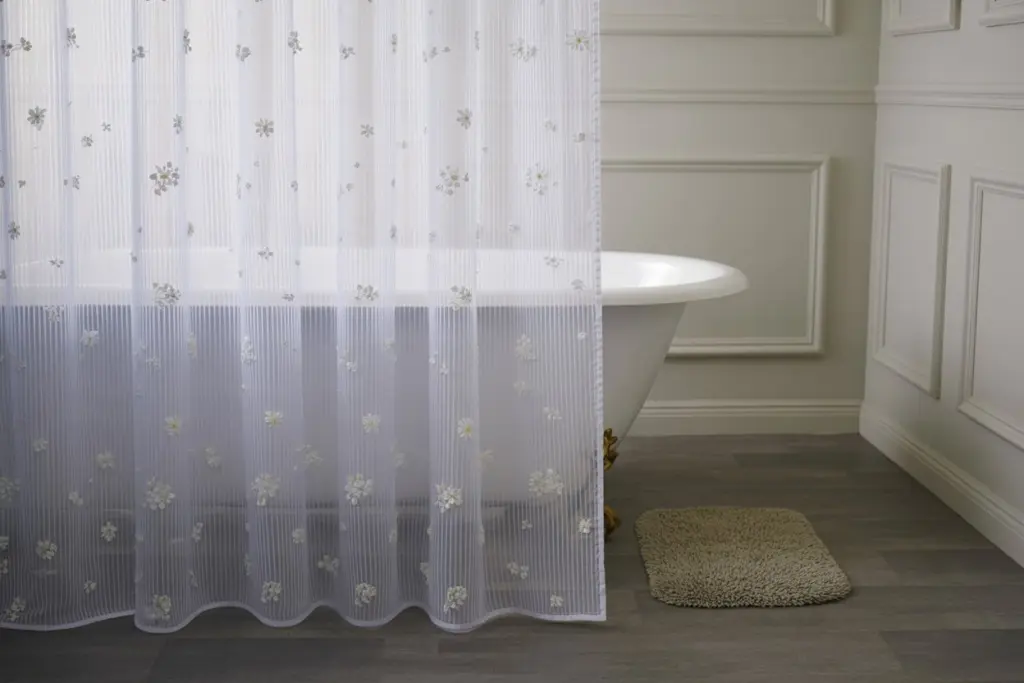
Bathroom accessories: Shower curtains in PEVA
Shower curtains made from PEVA (polyethylene vinyl acetate) have a number of features in common with PVC curtains, such as being waterproof, lightweight and easy to maintain.
The main difference is that PEVA curtains are 100% recyclable. They are also thicker and more resistant to mildew. As PEVA is of higher quality, shower curtains are more expensive but last longer.
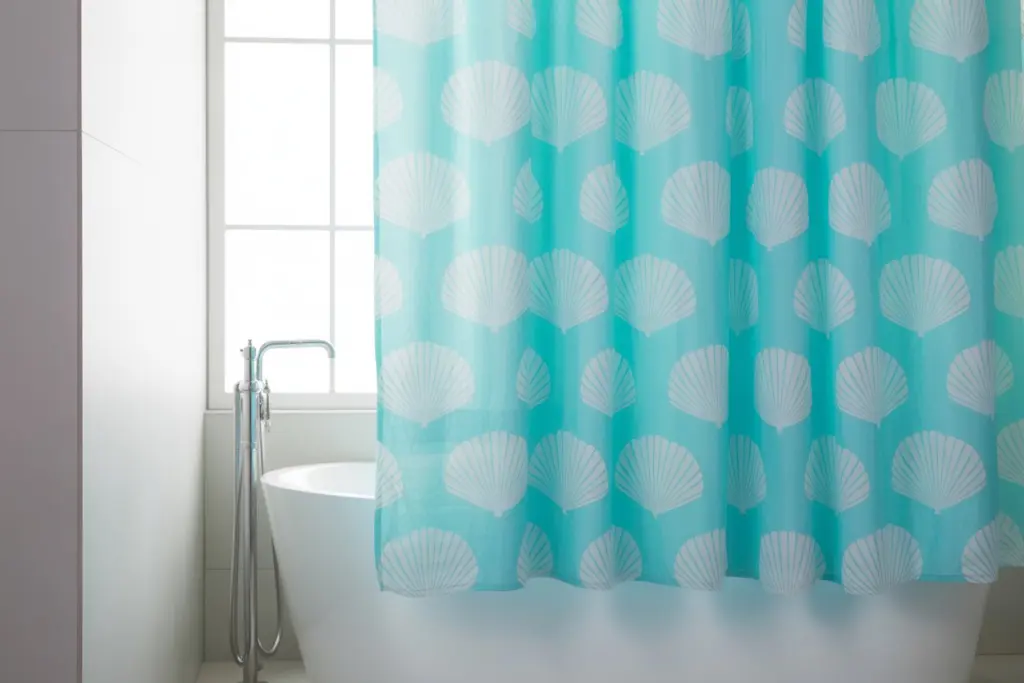
Tip: after showering, pull back your curtain to allow it to dry properly.
Fabric shower curtains
Cotton shower curtains
Cotton shower curtains are mainly appreciated for their aesthetic and decorative qualities. They are lightweight and come in a variety of elegant colors and patterns. They are even easier to care for than plastic curtains, as they can be machine-washed directly (at 60°C to limit bacterial growth).
However, these curtains are not waterproof and are highly susceptible to mildew. To avoid this, some manufacturers apply a plastic coating to the curtains, making them waterproof and more resistant.
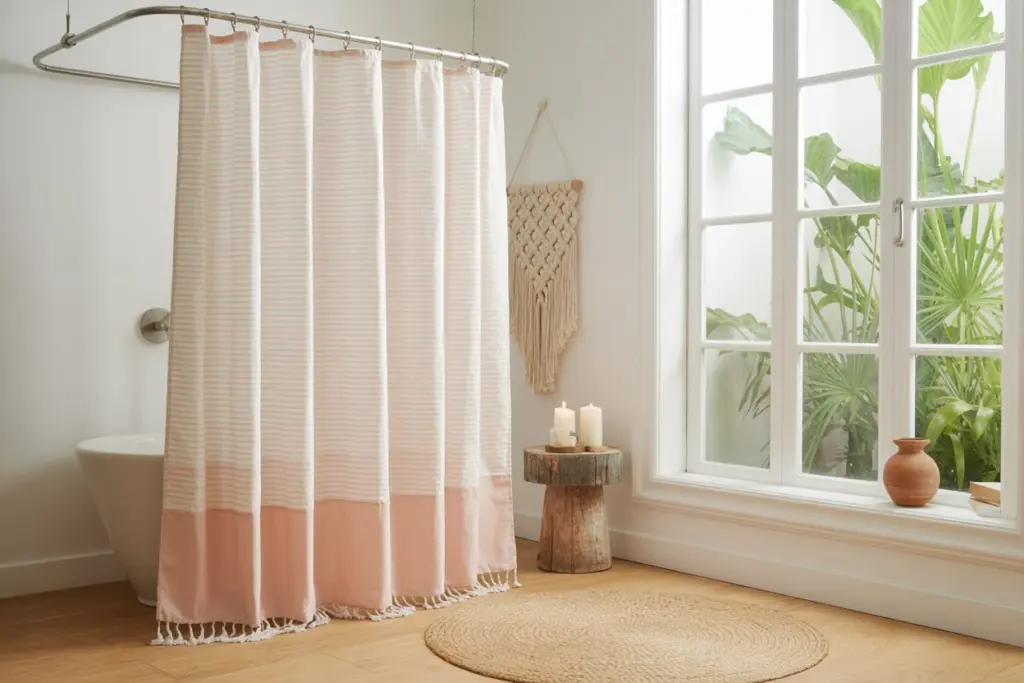
Nylon shower curtains
Nylon shower curtains are rarer on the market, but have important qualities. They dry faster, are slightly more waterproof and are more resistant to mildew than cotton curtains, as they are made of synthetic fabric.
For some, we see nylon as less aesthetic than cotton and more expensive. However, it is stronger and therefore more durable.

Polyester shower curtains
Polyester shower curtains represent the happy medium between plastic and cotton. They are both waterproof (more so than cotton) and aesthetically pleasing (more so than plastic). Like other fabric curtains, they can be simply machine-washed, and their durability is quite high.
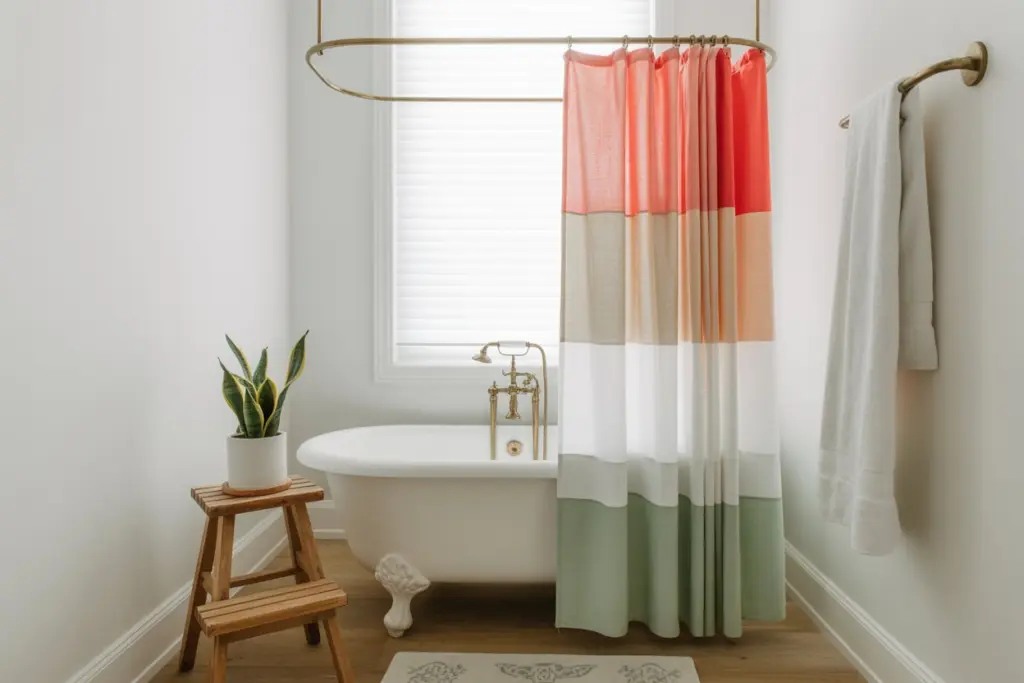
Hemp shower curtains
Hemp shower curtains are rarer, but appreciated for their eco-responsibility and natural antibacterial and antifungal (mildew-resistant) properties. They also last a long time.
They are not, however, waterproof, but as with other fabrics, they can be lined with a transparent PEVA shower curtain.
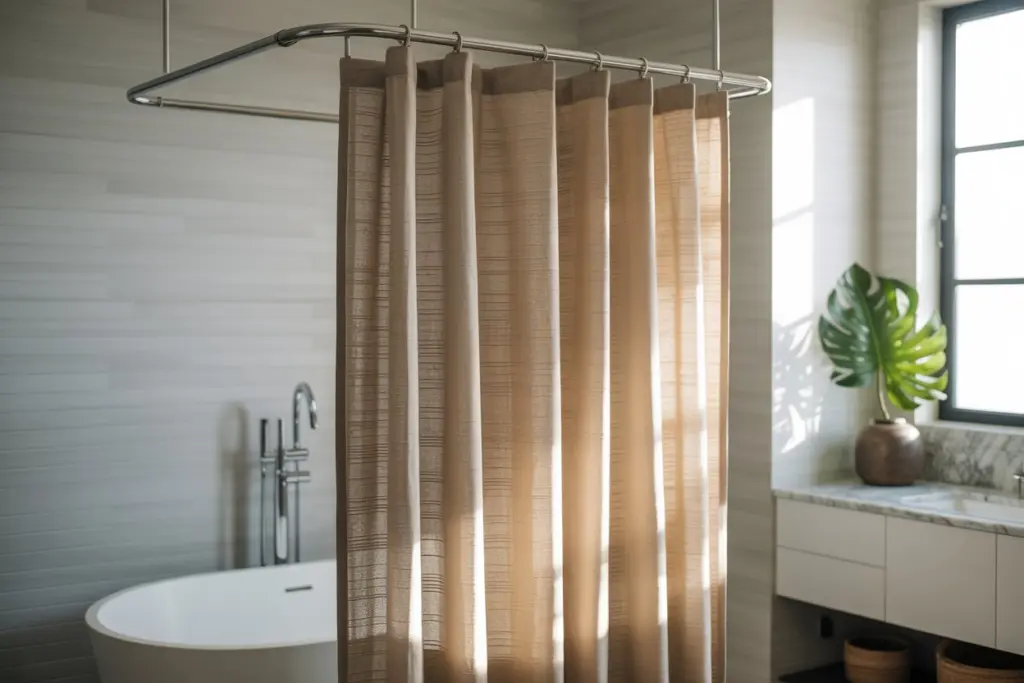
Tip: to make your fabric shower curtain waterproof, you can line the inside with another transparent plastic shower curtain.
Shower curtain accessories
These accessories are chosen according to the type of shower curtain you’re using and, once again, your personal decorating style.
The bar
The bar is available in straight (positioned between two parallel walls) or angled versions, as well as semi-circular or circular. It can be fixed either to the wall or directly to the ceiling.
The shower rail is fixed to a single point on the wall, while the curtain is supported by its numerous rods, which unfold like a fan.
Extendable or not, the shower rail is usually self-locking, thanks to a system of springs or suction cups. For heavy curtains, however, we recommend a screw-in model capable of supporting the weight of the curtain.
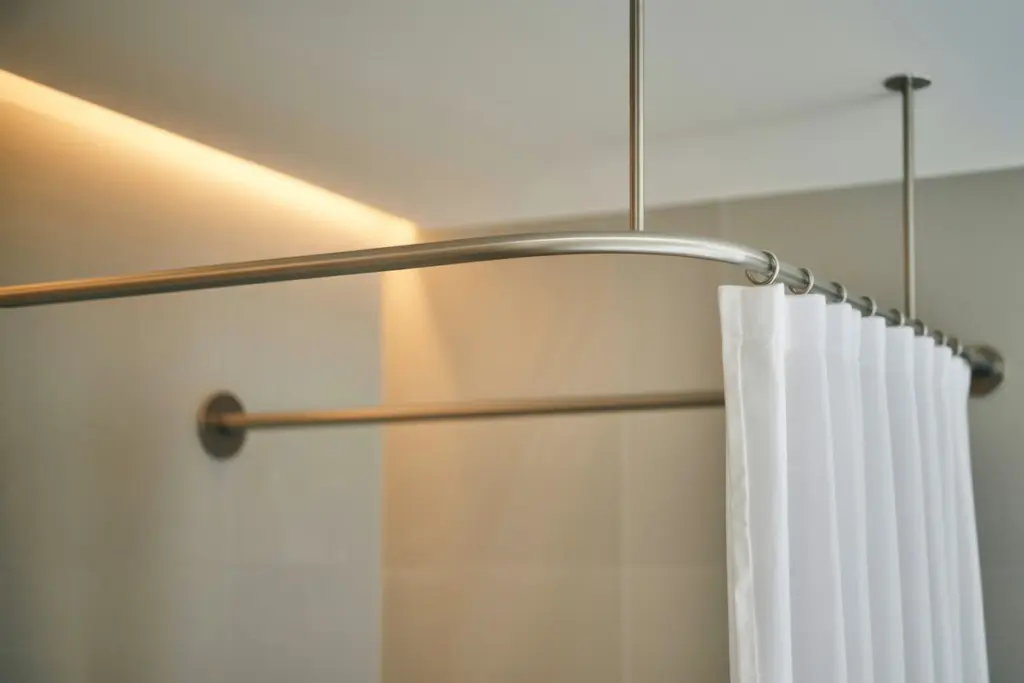
Tip: the bar is generally fixed at a height of around 1.90 m above the shower tray. If it’s set too high, the curtain will be difficult to handle, while if it’s too low, water will run over it.
The cord
More discreet than a shower rod, wire can make opening and closing the shower curtain more difficult.
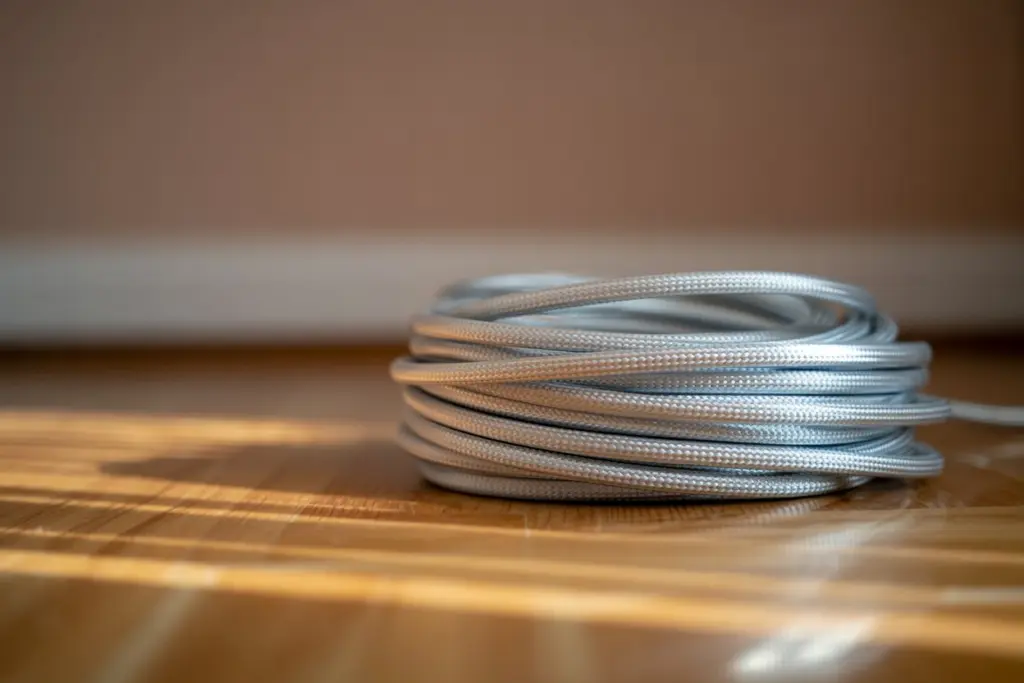
Shower curtain rings
Available in many shapes and colors, shower curtain rings should be aesthetically pleasing, but also easy to remove when you need to wash or change the curtain. They must also be strong enough to support its weight, even when wet.
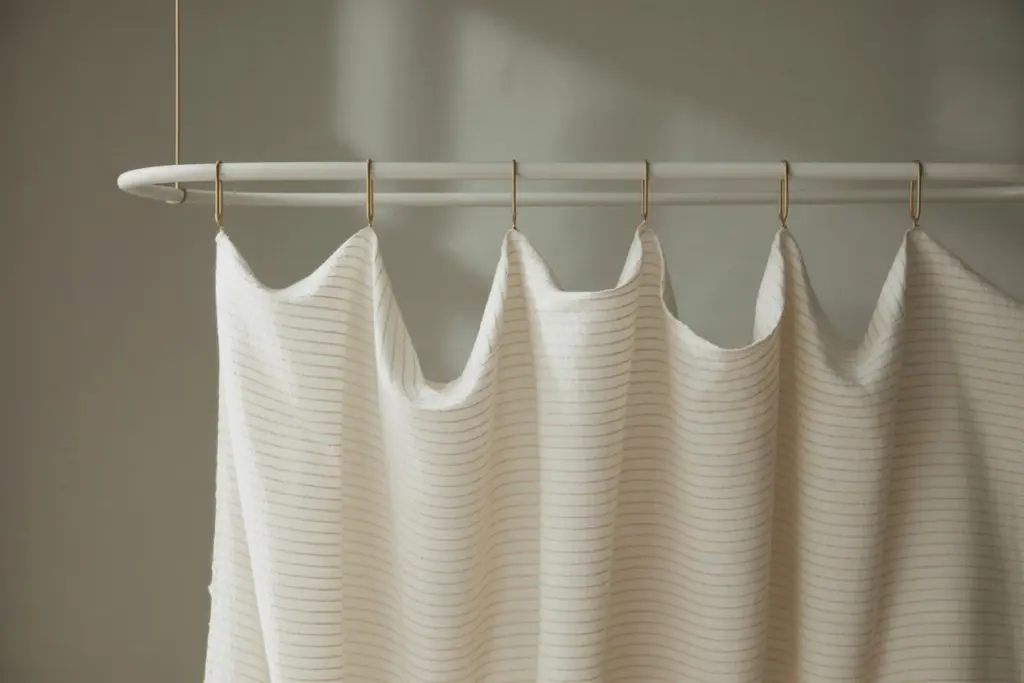
Note: some shower curtains attach to the rail without a ring for a sleeker design, but they don’t always slide easily.
Pockets
Some curtain models feature shower-side pockets, ideal for storing accessories such as shower gel or shampoo.
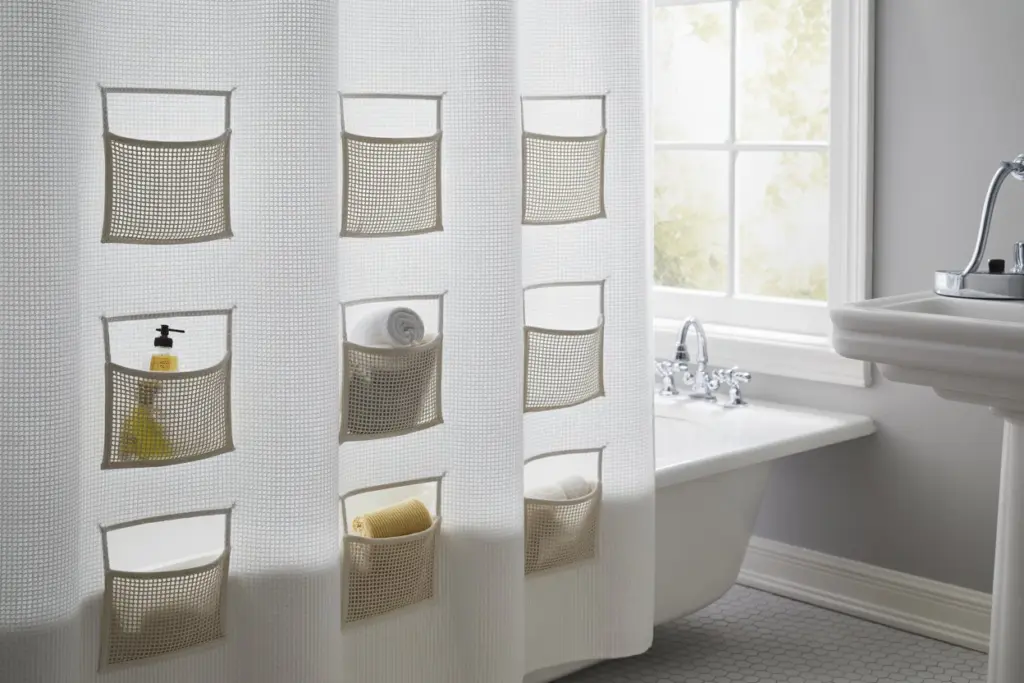
Bathroom accessories: How to choose shower curtain colors and design?
When it comes to choosing shower curtain colors and design, there are several factors to consider in order to create a visually appealing and cohesive look in your bathroom. Here are some tips to guide you:
Consider your existing bathroom decor: Take into account the colors and style of your bathroom. If you have dominant elements such as tiles, walls, or furniture in specific colors, choose a shower curtain that complements or matches those existing colors. You can opt for similar shades or complementary colors to create a harmonious visual flow.
Determine the mood and ambiance: Think about the atmosphere you want to create in your bathroom. Soft and soothing colors like pastels or shades of blue and green can create a calming ambiance. Bold and vibrant colors like red, yellow, or purple can add energy and liveliness. Choose colors that align with your desired style and ambiance.
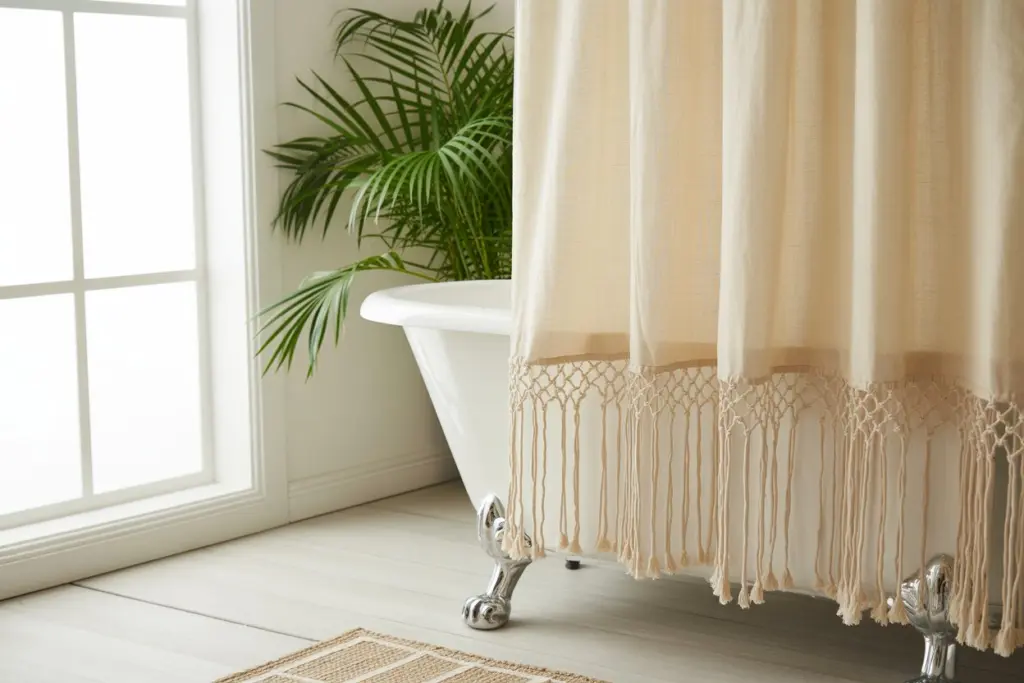
Consider the size and lighting of your bathroom: If you have a small or dark bathroom, lighter-colored shower curtains or light patterns can help create an illusion of space and brightness. If you have a larger bathroom, you can experiment with bolder colors or larger patterns to make a visual statement.
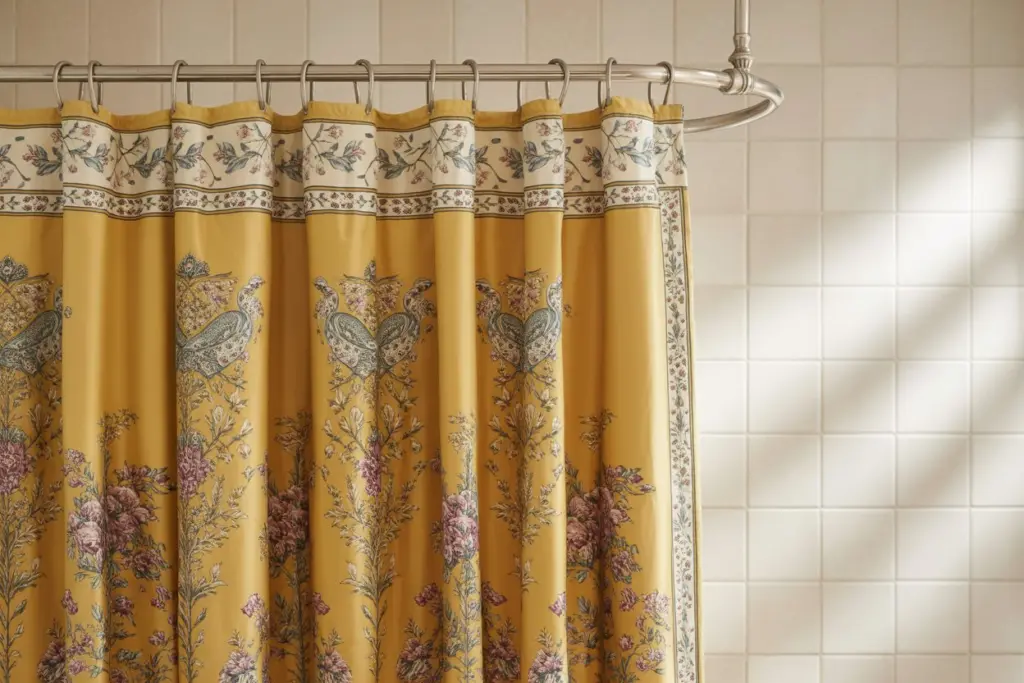
Reflect your personal style: The choice of shower curtain colors and design is an opportunity to showcase your personal style. If you prefer a minimalist and clean look, opt for neutral colors and simple patterns. If you enjoy bold designs, you can choose vibrant colors or geometric and floral patterns. Let your creativity shine through and select a shower curtain that reflects your personality.
